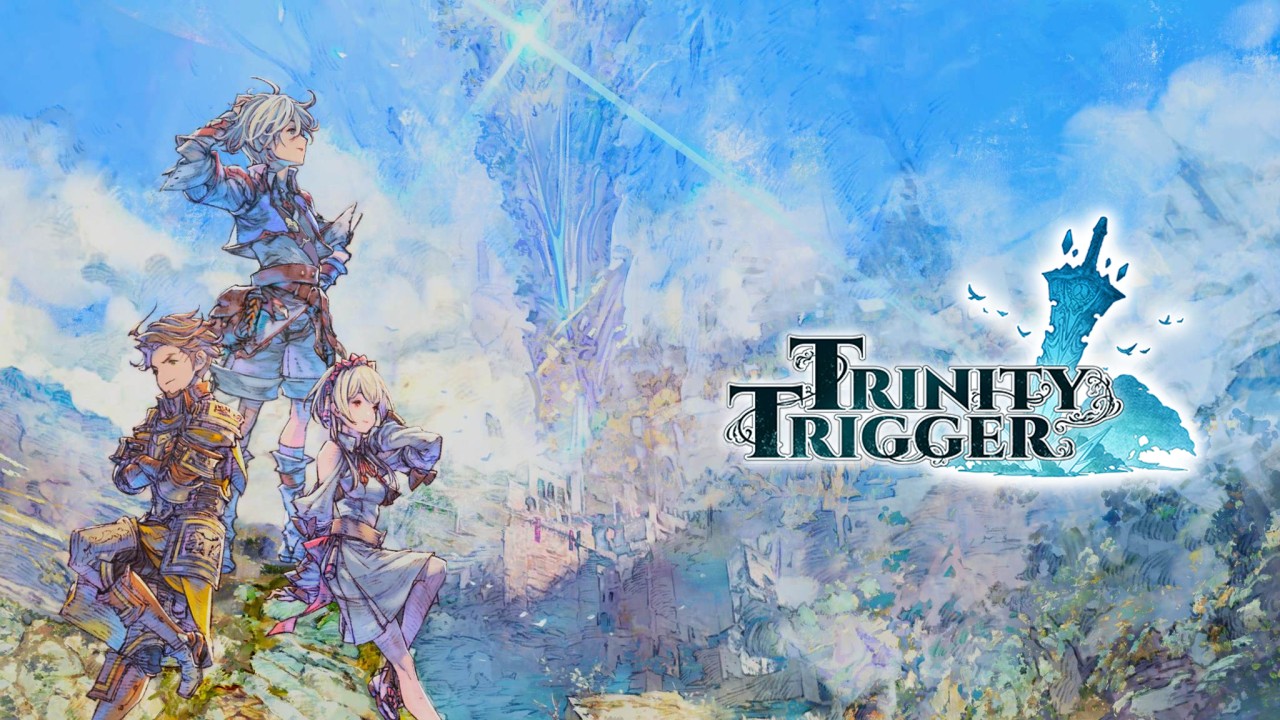I went into Trinity Trigger with no real expectations. From trailers, it looked like a fun little Action RPG, and its pedigree of developers (who previously worked on games like the Of Mana series, Chrono Cross, and Octopath Traveller) gave me some hope that I’d find myself in for something pretty good. However, after spending a little over 13 hours from start to finish with it, I walked away from my time with it ultimately disappointed.
A Promising Start
Trinity Trigger opens with some backstory on the world of Trinitia. A war between the Gods of Order and Chaos has been ongoing for so long that they’ve settled on using proxies to fight for them. There will always be a chosen warrior to fight for either side, and they’re fated to do battle to determine whether Order or Chaos will prevail. Enter the protagonist: Cyan. Born with the mark of Chaos, he quickly meets Elise, who has travelled to find him. She informs Cyan of his destiny, and in a nice little subversion, they join forces to oppose it. Cyan wants no part in it, and Elise leads him on a journey to find the Warrior of Order and essentially try and just talk it out instead of killing each other.
However, to get to find the Warrior of Order, they have to travel across the world of Trinitia, which is inhabited by a variety of monsters. With that said Cyan, Elise, and the third party member, Zantis (who they meet along the way) are each accompanied by a Trigger. Triggers are special creatures that can transform themselves into powerful weapons.
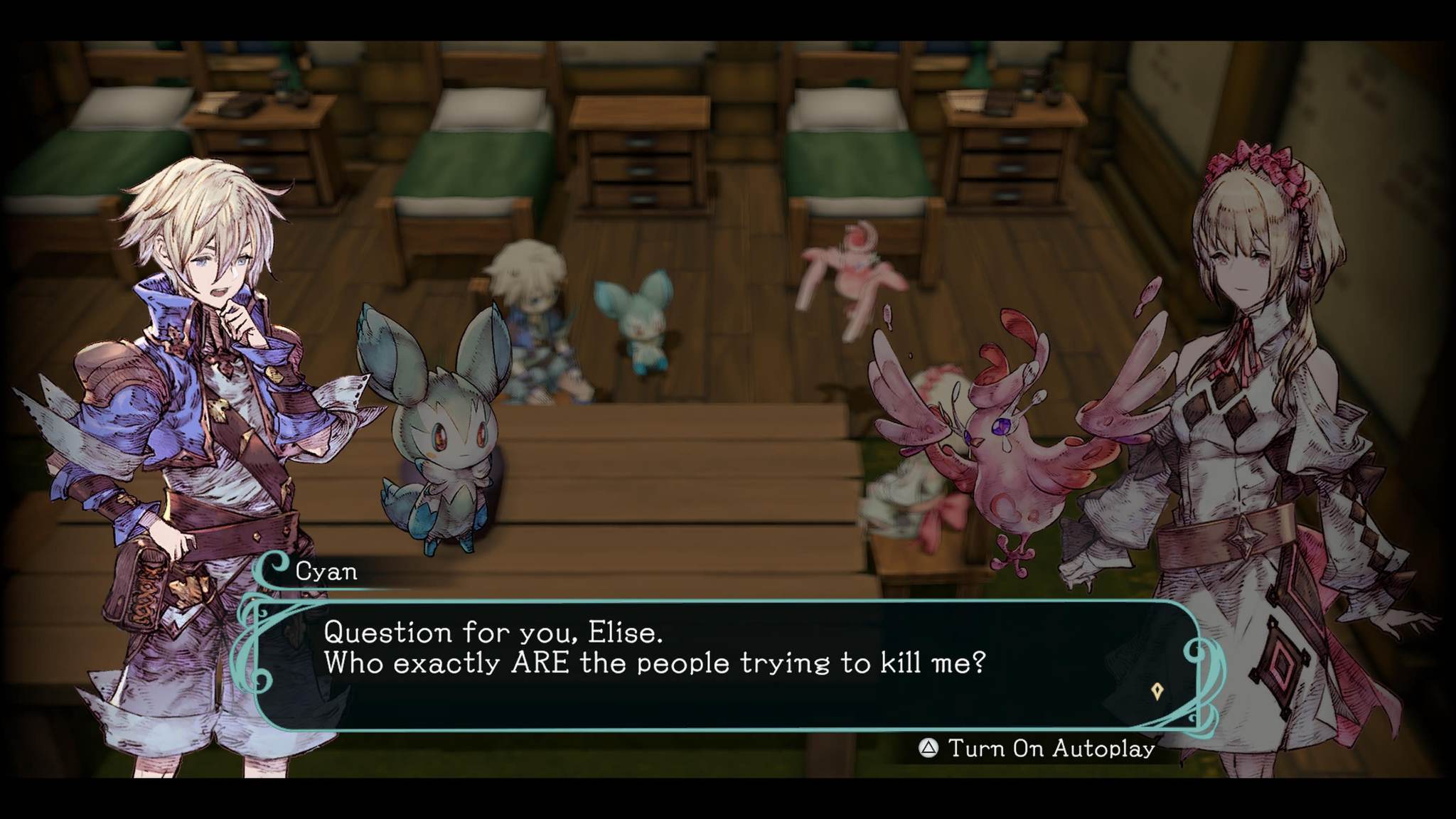
It’s a decent little set-up, helped along with some solid voice acting (available in both English and Japanese). It also helps that Trinity Trigger keeps its pace fairly quick. There’s little to no downtime if you’re just pushing through the story. Later on, the game does open up a little by giving you side quests dotted around the map, and while I did beat a few, a lot of them did just boil down to “go here, kill x enemy/enemies”.
It’s a shame that about 2/3rds into Trinity Trigger, its story kind of fell apart for me. Characters, while charming and well-performed, don’t have much growth or even much of a connection beyond “we have to stop this”. There’s so little development in the story that it felt like it rushed towards the ending. Things just kind of started snowballing in the last third, with an out of nowhere plot twist/reveal and a final couple of areas that felt a lot less cohesive than any of the others before it. It honestly felt like the game that had a whole act just cut out of it. There’s also the final dungeon/boss, but before I can talk about my issues with that, I need to talk about Trinity Trigger’s combat.
Combat Problems
Much like its premise, the opening hours of Trinity Trigger’s combat seemed very promising. Each weapon has a 3-hit combo, but where it got interesting was the idea of how customisable those combos could be. For each attack in the combo, you can pick one of two different moves. These moves can vary wildly, like the final move in a bow’s combo being either a leap backwards for defensive purposes or leaping towards the enemies to close the distance and switch to a melee weapon.
I liked this a lot as a concept, as it gave the impression that I’d be able to learn new moves for weapons to hone in on a combo I liked. However, that’s all you ever get. Each of the 8 weapons you can acquire for each character just have those two options for each hit of their combos. You can raise the damage of these moves at Shrines (save/fast travel points) at the cost of TP earned by defeating monsters, but that adds another issue I have with Trinity Trigger.
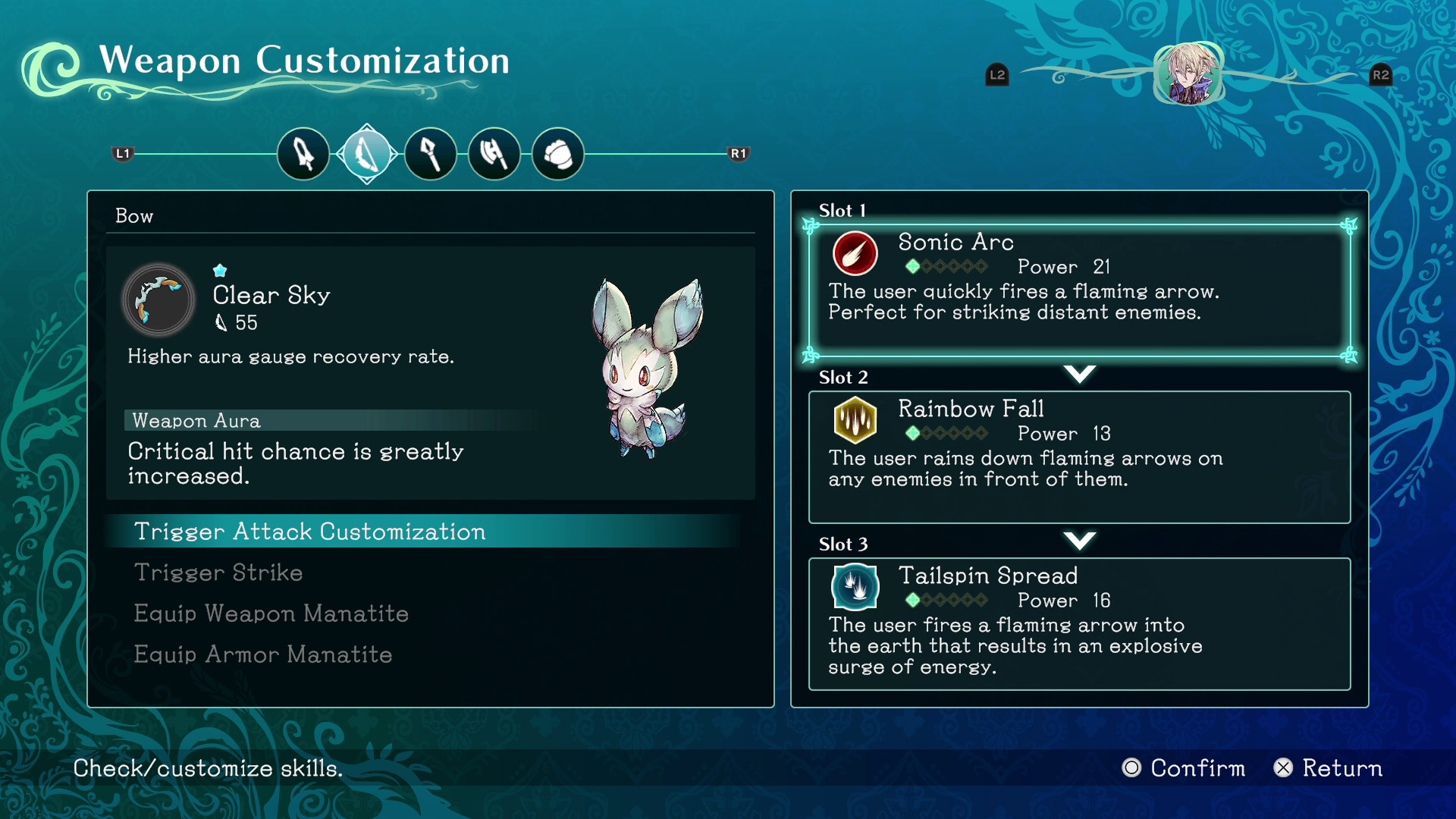
If you want to give each character the most power for each of their weapons you need to raise each of the 6 moves per weapon per character 5 levels. These levels get exponentially more expensive, and that means you’ve gotta go grind for TP (the resource used to upgrade attacks). And in the grind, that’s when you start to feel the diminishing returns of this investment: it never gets to be more than a stat increase. You can find/craft equipable accessories to your Triggers called Manatite, but they’re also just stat increases. What’s even more frustrating is that some of the stat increases that these Manatite will give you will be useful information like” Max HP +20%”, but others will be along the lines of “Chance to negate damage: B+”. I don’t know what “B” refers to, and the game never gives you a stat table for what these letter grades mean in raw numbers. It’s baffling that they’d use both of these instead of just picking one.
Trinity Trigger’s combat slowly revealed a lot of issues for me. First is that lack of tangible feeling of your party getting stronger because all you get is a bigger number. Yes, you unlock different weapons as you progress, but no character feels unique beyond a couple of slightly different attacks per character. Combat progress is never anything substantial, so it never felt rewarding, and by the end of the game, I found myself just running through areas because I couldn’t be bothered fighting non-essential enemies. If each character had said 3 or 4 unique weapons instead of them each eventually being able to use all 8 it would at least give me a reason to switch between characters per encounter.
Menu Heavy Combat
This leads me to my second big issue with Trinity Trigger’s combat. I don’t think I’ve played an action RPG that wants you to spend more time pausing its combat to switch to another weapon. Enemies have weapon types that they’re strong, weak and, occasionally, completely resistant to. This becomes more of an issue the further into the game you get. The more weapons you have, the more you need to open up that menu and switch between them. And this can happen multiple times per encounter. If a group of enemies has 3 enemy types, chances are each enemy could be resistant to 3 different types of damage. So, to play optimally, you’d need to keep opening your menu and switching weapons. There is a shortcut system in place, letting you map a weapon to each direction of the d-pad, but I’d still constantly be opening my weapon wheel to switch out weapons because I didn’t have the right weapon in my shortcuts. Again, this is a problem that could’ve been solved if each character had a more limited selection of weapons. This would go a long way to making each character feel unique, giving some motivation to switch between characters beyond “Cyan died, so I have to switch”.
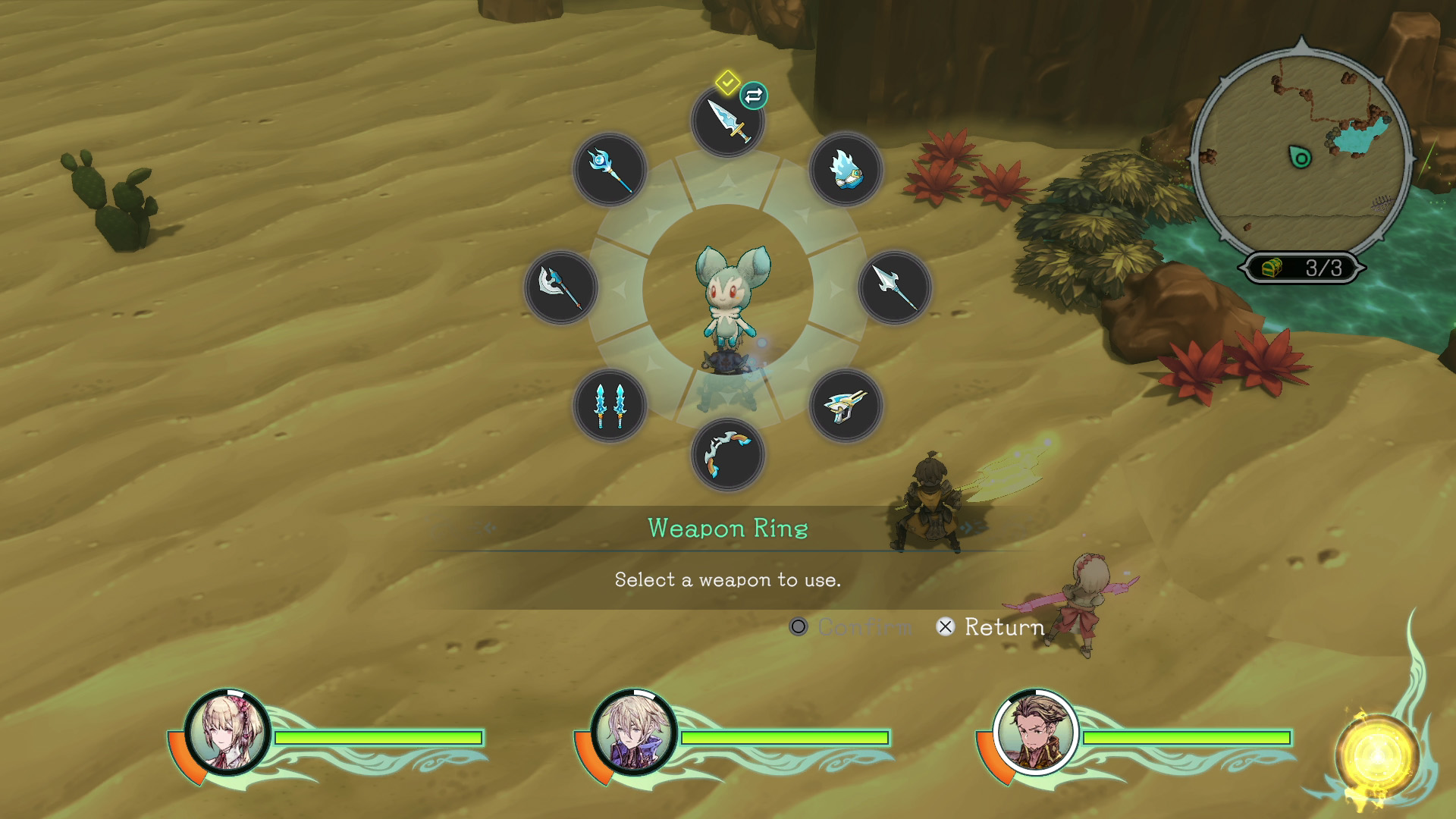
You also have to navigate a second wheel for items. This wheel is made up of 4 categories (with one shortcut per category) and each category is ANOTHER wheel in itself. There’s so much menu management that it completely breaks the flow of combat in a lot of the game’s bigger fights. It at least pauses when you’re in the weapon or item wheel so you’re not at risk of taking damage, but it feels so antithetical to what an action RPG can be.
There’s also the Synchro Gauge, which is stamina in all but name. Each hit of your combo takes a chunk out of the Synchro Gauge, and once it’s depleted all your attacks become significantly weaker until you let it refill. I hated this system. Not because stamina systems are bad, but the ability to keep attacking while it was empty, which also stops it from refilling meant I wasted a lot of time doing bad damage. I don’t understand the decision to let you attack at all once it’s empty. If you want me to wait for it to refill anyway, just make me unable to attack until it refills. I think it’s to encourage the use of the dodge. If you time a dodge just right, you’ll refill some of your Synchro Gauge: it’s a solid idea that gets you more engaged in combat instead of just mashing. There are a couple of issues with this, however. For one, the enemy AI isn’t particularly good, so in the time it can take them to even try and attack, your Synchro Gauge has already filled, negating the need to dodge at all. Secondly, the game is loaded with particle effects for all your attacks. It looks very nice, but because of the top-down camera and relatively small character models, attacks frequently get lost in a mess of effects, making it incredibly difficult to judge when an enemy is attacking at all.
Another small, but very specific combat gripe I have is with Trinity Trigger’s combat barks. After every attack you or the AI make, the party will shout or grunt and it never stops. There are no options to reduce the frequency of these, and there’s just enough variation that I was never able to tune it out, but not enough variation to stop it being incessantly annoying. I say specific gripe purely because I do have some audiosensory issues and this is one of the ones I have a lot of trouble with.
My biggest gripe with Trinity Trigger’s combat, however, is how terrible the party AI is. I mentioned in the previous section that I had issues with the final boss/dungeon. The party AI is so awful, that during the final boss, both AI-controlled party members would just walk into huge area of effect damage zones that the final boss would leave throughout the arena. Not once did I see an AI-controlled character walk AROUND the big spheres of pain the boss throws out, they’d just walk right through, taking constant damage. What’s worse is that when you take damage there’s a little bit of hit stun, but the AoE is so big that they’d get hit, stunned, and then hit again 2 or 3 times per AoE, and the boss could leave 2-5 of these with every attack. It brought to light something that I hadn’t really noticed previously, but in retrospect was there all along: your party members just aren’t particularly smart. The only thing about their AI I appreciate is that they’ll never instigate a fight, letting you backtrack through areas quicker. But they’ll also never switch their weapons when they’re fighting, leading to many fights where I’d eventually notice the damage numbers they were dealing were all zeroes. It’s worth noting that Trinity Trigger does have up to 3 player local co-op, but that’s not a fix to the issue for the bulk of players who are likely to play this solo.
Carried by its Charm
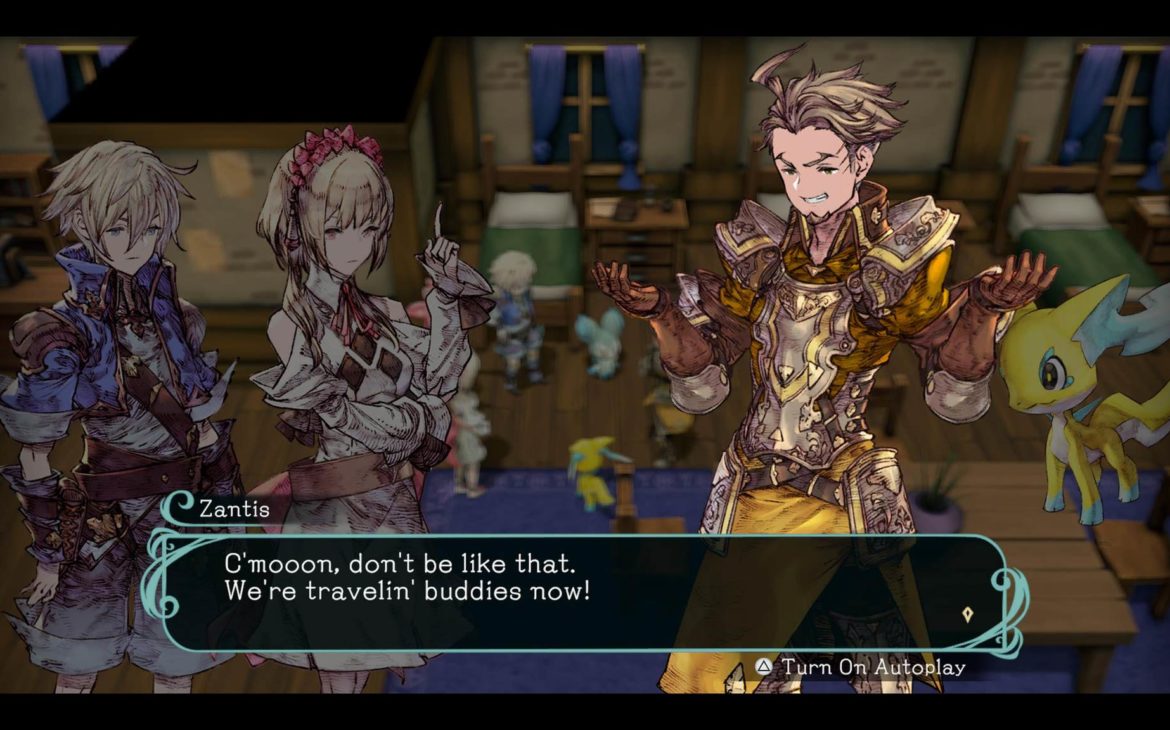
I think the reason I have so many frustrations with Trinity Trigger is that I wanted to love it. There are a lot of good ideas buried under my frustrations, and while it likely reads that I hated my time playing it, I really didn’t. It was only the very last boss that I found to be genuinely bad. The first few hours did a lot of good and had me engaged throughout. The world of Trinitia is full of cool details. Each dungeon is a giant weapon that fell from the heavens during the Gods’ war, and they match up with the weapons you eventually earn. There’s even a post-game, with a bunch of hidden bosses throughout the world and at least 5 super bosses that require you to heavily explore the world to access. There are glimmers of really solid character moments but they’re so few and far between that I couldn’t help but be disappointed there wasn’t more. Combat has some depth with the combo system, but I wanted more from it. It really does feel like this game is missing a large amount of content. The world is so rich in backstory but that’s all it ever is. There will absolutely be an audience for this game, its aesthetic alone is probably gonna pull some people in, but for me, it just never came together the way that I was hoping, and I couldn’t help but be disappointed by its end.
While it started as a solid ARPG, Trinity Trigger quickly began to disappoint. Its charming world didn’t matter because I didn’t care about anyone in it. Its combat had a solid base but a lack of variety in its encounters made it bland. Worst of all, Trinity Trigger’s final third rushes towards an ending that felt unearned, with an awful final boss that highlights how poor the party AI is.

Trinity Trigger is available April 25th (NA)/May 16th (EU) on PlayStation 4, PlayStation 5 (review platform), Nintendo Switch, and PC.
Developer: FuRyu
Publisher: Xseed Games
Disclaimer: In order to complete this review, we were provided with a promotional code from the publisher.
For our full review policy, please go here. If you enjoyed this article or any more of our content, please consider our Patreon.
Make sure to follow Finger Guns on our social channels. Twitter, Facebook, Twitch, Spotify or Apple Podcasts – to keep up to date on our news, reviews and features.
